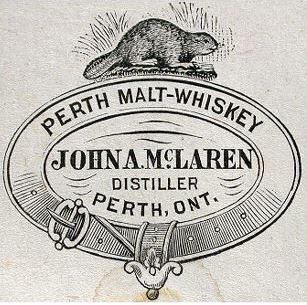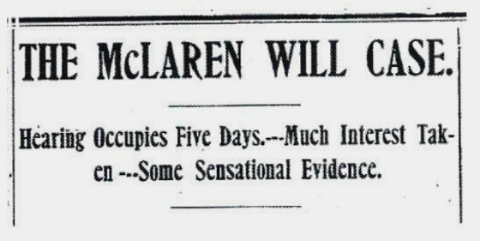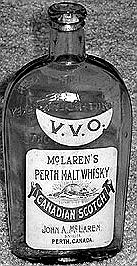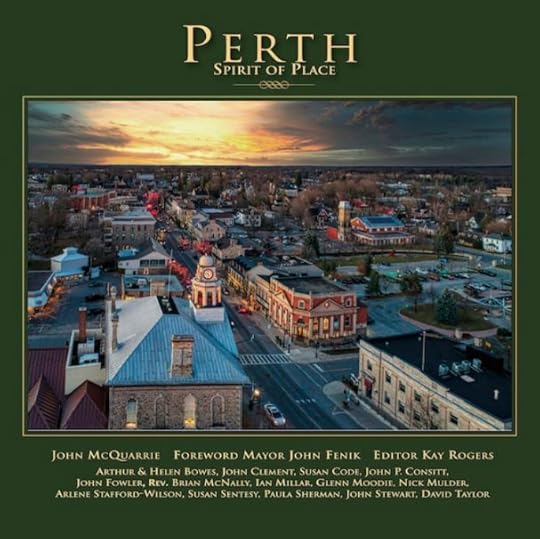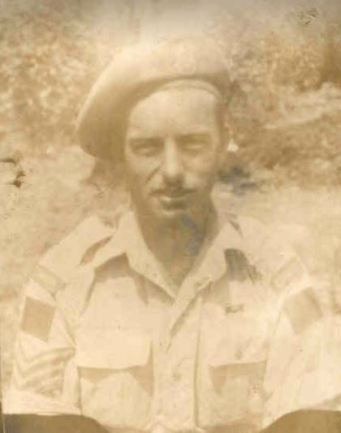Arlene Stafford-Wilson's Blog, page 24
December 31, 2022
Lanark County Scottish New Year – Hogmanay
Among the earliest settlers to Lanark County were Scots who came from Glasgow and Lanarkshire, after the Napoleonic war. These immigrants settled mostly in the townships of Dalhousie, Lanark, North Sherborooke and Ramsay. In 1820, approximately 400 families arrived in Lanark County, bringing their skills in cotton weaving, carpentry, blacksmithing and shoe-making. Many of these Scots also brought their traditions from the old country, and one of their most beloved was their New Year’s known as Hogmanay.
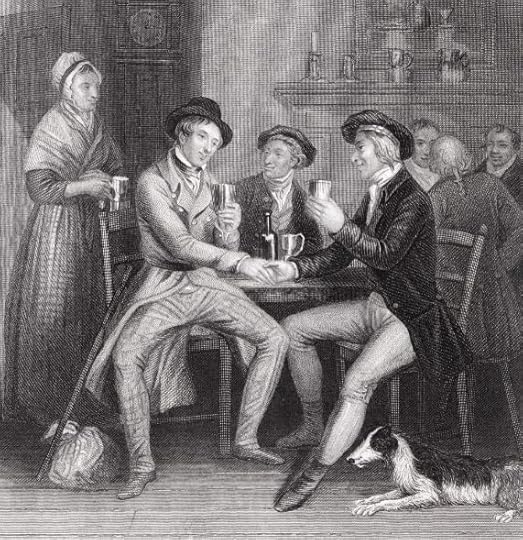
Many of these Hogmanay traditions were brought to Scotland by the Vikings in the early 8th and 9th centuries. In some parts of Scotland, like Shetland, the Viking influence remains strong, and New Year is still called ‘Yules’, derived from the Scandinavian word for the midwinter festival of Yule.
Christmas was not celebrated as a festival and was banned in Scotland for around 400 years, from the end of the 17th century to the 1950s. This was because of the Protestant Reformation movement, when it was believed that Christmas was a Catholic feast, and should be banned.
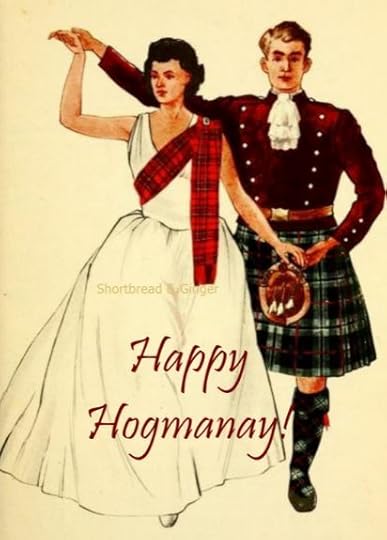
Hogmanay Traditions
It was customary to clean the house, and take out the ashes from the fire. It was also a requirement to clear all your debts before “the bells” sound midnight, the underlying belief was to clear out the remains of the old year, and have a clean slate to welcome in a young New Year.
First Footing
First Footing refers to the first person to cross your threshold after midnight on New Year’s Eve. They must be dark-haired, which is an ancient tradition going back to the days of the Viking invasions, when a fair-haired person could mean trouble for your household.
They must be bearing gifts, and specifically – a half-bottle of scotch whisky, a generous piece of black bun, a few pieces of coal. The whisky and black bun is to ensure that the home has food and drink in the coming year, and the coal is symbolic that the home will be warm in the year ahead.
Once the first footer crosses the threshold (and they can be turned away if they are light-haired), they are led through the entire home. When the tour is finished they place the coal on the fire, offer whiskey to the family, and the black bun is sliced and shared. Next, they kiss every female in the home, and wish them all the best in the new year.
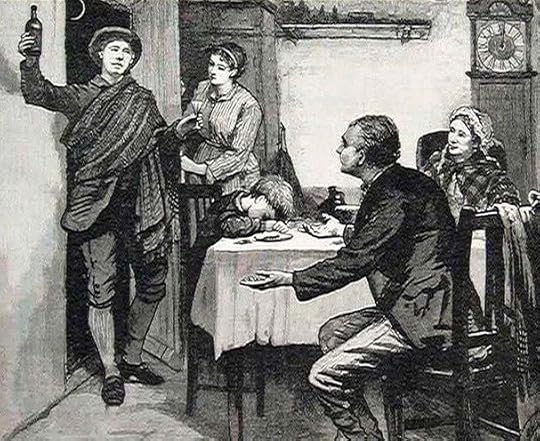
“The first-footer should be dark complexioned,
and their name begins with straight, not curvy letters.“

First Footing Rules
The first footer brings all the luck, good or bad, for the year ahead.
They should be male and dark-haired.
They may not be doctors, members of the clergy or grave-diggers, and must not have eyebrows that meet in the middle.
They should bring whiskey, coal, and black bun.
A first footer may claim a kiss from every woman present.
If your First Footer doesn’t meet all the requirements, then the household is heading for an unlucky year.

A toast is made by the First-Footer before he leaves – ” A good new year to all and many may you see”
Torchlight Parade
Fire also plays a special role in Hogmanay customs, and originates in the pagan traditions of the pre-Christian Celts. In modern times, the annual Torchlight Procession in Edinburgh continues with thousands marching through the city center carrying blazing torches.
Scottish Black Bun

Black Bun recipe:
Pastry Case
3 c flour
1/2 tsp baking powder
6 Tbsp lard
6 Tbsp butter
1 pinch salt
Cold water
Filling
2 ¾ c seedless raisins
2 Tbsp brandy
1 Tbsp milk
2 ¾ c currants
1/3 c chopped almonds
1 pinch black pepper
¼ c mixed peel
1 ½ c flour
1/3 c brown sugar
1 tsp allspice
1/2 tsp ground ginger
1/2 tsp ground cinnamon
1/2 tsp baking powder
1 large egg beaten
Method
Grease an 8-inch loaf tin. Blend the lard and butter into the flour and salt and mix in cold water to make a stiff dough. This will be used to line the tin. Roll out the pastry and slice into six pieces to fit the bottom, top and all four sides of the tin. Press into the tin, pressing the overlapped sections to seal.
Mix the raisins, currants, almonds, peel and sugar together. Sift in the flour, add the spices and baking powder, then mix together with the brandy and most of the egg. Add enough milk to moisten.
Place the filling into the lined tin and top with the pastry lid, sealing the edges. Lightly score the surface with a fork.
Brush the top with milk to create a glaze.
Bake in a pre-heated oven at 325F 2-3 hours. Test with a skewer which should come out clean; if not, continue baking.
Cool in the tin and then on a wire rack.
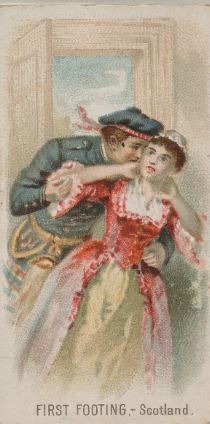
A First-Footer kisses every woman in the household
Auld Lang Syne
Immediately after midnight it is traditional to sing Robert Burns‘ “Auld Lang Syne”. Burns published his version of this traditional New Year’s song in 1788, although it is said the original was written 80 years before that.
To sing ‘Auld Lang Syne’ the traditional Scottish way, a circle is formed and hands are joined with the person on either side of you. At the beginning of the last verse, everyone crosses their arms across their chest, so the right hand reaches out to the neighbour. When the song ends, everyone rushes to the middle, still holding hands.
“Should auld acquaintance be forgot and never brought to mind?
Should auld acquaintance be forgot and auld lang syne
For auld lang syne, my dear, for auld lang syne,
We’ll take a cup o kindness yet, for auld lang syne.”
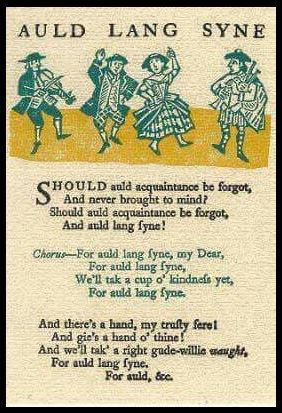
New Year’s Morning
Saining the HouseThere is a Scottish highland custom of saining (blessing) the house and and the livestock, and is still practised today, mostly in rural areas. The ritual involves the drinking of water believed to be magic which must be sourced from a river ford that’s said to be crossed by both the living and the dead. Next is the burning of juniper branches, enough to fill the house with smoke, and is believed to cleanse the house and drive away evil spirits.
After these two rituals are completed, the windows and doors are opened to let in fresh, New Year air, and a wee nip of whisky is taken before indulging in a hearty Scottish breakfast.

“Out with the Old, and in with the New!”
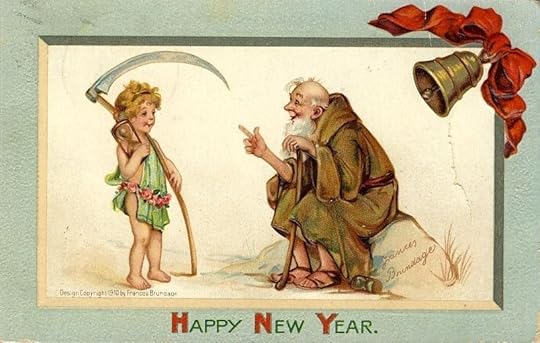
Scottish New Year’s Blessing

Happy New Year!

Arlene Stafford-Wilson
Member, Association of Professional Genealogists
Honorary Life Member, Lanark County Genealogical Society
Author of : “Lanark County Christmas”, “Lanark County Comfort”, “Lanark County Collection”, “Lanark County Calling”, “Lanark County Classics”, “Lanark County Connections”, “Lanark County Calendar”, “Lanark County Chronicle”, “Lanark County Kid”, & “Recipes & Recollections”
available at local stores or email: lanarkcountybooks@gmail.com
November 26, 2022
Perth’s Millionaire Bachelor – Who Inherited His Fortune?
First to manufacture ‘the Mickey’ – liquor in a 12 ounce bottle, Perth native John McLaren made his fortune distilling alcohol.
A Mickey is actually one of a series of uniquely Canadian alcohol measurements. “Two four” (a case of 24 beers), “twenty-sixer” (a 750 ml bottle of liquor) and “forty-pounder” (a 1.14 liter bottle of liquor) are all virtually unknown outside of Canada.
The very first ‘Mickey‘ was John McLaren’s “Old Perth Malt Whiskey”, a bottle could be had for .80 cents, and was hailed as being “equal to the best ever brewed in Scotland”. Most whiskies in those days were aged very briefly, usually four days or less, and McLaren aged his for a full month before it was distributed to the local bars and liquor stores around Lanark County.
“McLaren’s Whiskey – Aged for a full month!”“.90 cents for a mickey, – .80 cents if you bring your bottle back for a refill…”Robert McLaren, an enterprising young man from Scotland, founded the McLaren Distillery in Perth, in 1841, on a section of land known today as Stewart Park. He died before his son John, came of age, and the business was placed in a trust with Robert’s wife, John’s step-mother. John took over the distillery around 1866 when he was in his mid-thirties.

Some say it was the combination of the clear waters of the Tay River and the secrets learned from the Scots that led John to become the local ‘Whiskey King’ or ‘Baron of Booze’.



A favourite among whiskey judges, Old Perth Malt Whiskey enjoyed a unique reputation and even some doctors of the time regarded it as “non-injurious”. It became a household staple, said to cure everything from flat feet to the common cold. The popularity of McLaren’s whiskey grew in leaps and bounds, and in its heyday was sold from coast to coast, all across Canada.
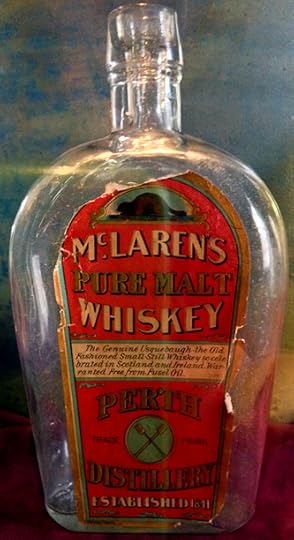
John laboured day and night, expanding his operations, and became the town’s wealthiest businessman. Some say he was secretive, reserved, and was not one to discuss his personal or business matters.

 Photo above: J.A. McLaren Distillery – located behind the town hall in present-day Stewart Park.
Photo above: J.A. McLaren Distillery – located behind the town hall in present-day Stewart Park.
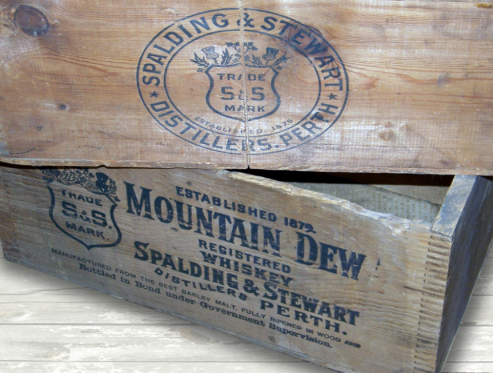

He never married, had no children, and for the most part lived a quiet life and kept to himself. When John McLaren passed away at the turn of the century, many in the town of Perth began to speculate – who would be the heir or heirs to his fortune?

By 1902 the town of Perth was “never more absorbed in one topic of conversation” as they were during the trial held in the local courtroom to settle the case of John McLaren’s Will.
Frank Walker, long-time employee swore that John McLaren had confided in him about his childhood and they shared a special relationship.

Walker told the court that John promised he would be taken care of from the proceeds of John’s estate”
“If I die tonight, you are provided for.”
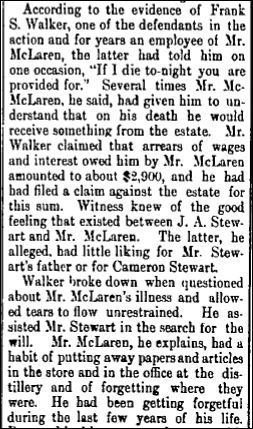
John A. Stewart, McLaren’s nephew, well-known Perth lawyer, and respected member of parliament, claimed that he drafted a will for Mr. McLaren in 1897, witnessed his signature on the document, and that his uncle had left everything to him.




Many people in Perth thought John McLaren left his millions to Minnie Hamilton. The lovely Minnie was known as his ‘favourite’. She was McLaren’s live-in ‘housekeeper’ in their hideaway home outside of Lanark:
“Everyone knew that Minnie was his special girl!”

………………………………………..
Many local businesses carried spirits manufactured by McLaren’s Distillery in 1903:Smiths Falls: 9 hotels and 1 store
Carleton Place: 8 hotels
Perth: 7 hotels and 2 stores
Franktown: 2 hotels
Ferguson’s Falls: 1 hotel
Innisville: 1 hotel
Maberly: 1 hotel
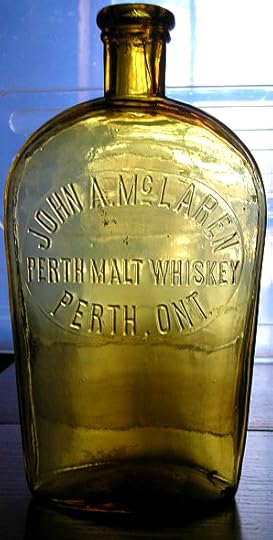
“The year 1896 was a good period for the hotel industry in Perth. Five recorded hotels flourished within the town boasting a grand total of 165 rooms, and five bars.
According to 19th century observers, Perth had a high caliber of service, and had an excellent reputation as a fine hotel town. One such observer was the old Perth Expositor which noted how strangers “always judge a town by its hotels” and then carried the impression of hospitality and service to the far reaches of the land.
The hotel business of 1898 was a vast improvement over the rude taverns and inns of early days. Several of the hotels survived the turn of the century and can be readily seen in today’s busy commercial trade. The only hotel still bearing the same name and remaining in the same location is the Revere House at Wilson and Foster.
The hotels of Perth began just prior to the Boer War, and were five: Barrie’s Hotel, Hicks House, Allen House, Revere House and Queen’s Hotel. They were all located in the business section of down town Perth and catered to a through trade from road, stage and traveling salesmen. Since 1900 the road trade has shifted west to Highway 7 where an assortment of motels enjoy a lucrative business from an almost entirely auto trade.
In 1896 the oldest hotel was Barrie’s operated by Thomas Barrie. It had thirty rooms and a well stocked bar. A resort of the surrounding farming community, the hotel enjoyed a heavy seasonal business. Mr. Barrie was hailed as a “jolly good natured fellow” with a “pleasant greeting” for all.
The Hicks House, now the Perth Hotel, was hailed as the “leading commercial hotel” in eastern Ontario, sporting a bar, billiard room, free bus rides and a variety of fare on the table. The proprietor was John Wilson, noted for his catering and disciplining of the “hotel attaches”.
The Queen’s occupied thirty rooms, a bar, a billiard room and stables across from what is now Girdwoods Store on Foster Street. Owned by Frank A. Lambert, father of Edward Lambert, present day proprietor of the Imperial Hotel on Wilson, the Queen’s closed its quarters in 1918 after purchasing Barrie’s from James P. Hogan who succeeded Mr. Barrie as operator. Queen’s and Barrie’s are thus the modern day Imperial Hotel operated by Ed Lambert who took over from his father in 1934.
In 1896 Revere House was a 25 room establishment run by W.J. Flett who is described as one of the best hotel men in the valley. He enjoyed a popular local trace.
Largest hotel in Perth, now closed to business, was a fifty room spread called the Allan House, situated to the west of the town hall in a block now occupied by Chaplin and Code and the Coin Wash. Andrew Robinson the proprietor, was famous for his “uniform courtesy and kindness” and the free bus rides to the train and stages. Mr. Robinson purchased the Allan House from I.C. Grant after ten years as an employee of the Hicks House.
Needless to say, the hotels of Perth had close connections with Crystal Sprine Brewery and McLaren’s Distillery, two enterprises which made Perth famous from Nova Scotia to British Columbia.”
(article published in “The Perth Courier” 1964)

……………………
Did one of these Business Owners in Perth inherit McLaren’s money?Someone in Perth got McLaren’s millions!*images of John McLaren, his whiskey, and ads for the Perth Distillery, and transcripts of the McLaren will case – from – “The Perth Courier”photo – Henry Kehoe in front of Spalding and Stewart Distillery – “The Perth Courier”photo – McLaren’s amber glass whisky bottle from ‘Collectable Treasures’photos – malt whiskey bottle, whiskey jug, old distillery photos – Perth Remembered“So, who inherited John McLaren’s vast fortune?”Did his ‘girl’, Minnie Hamilton inherit McLaren’s millions?Was it his nephew, George Rogers?Did lawyer John Stewart get the money?Was it his half-sister, Lizzie McIntyre?Did he leave the money to business manager,Frank Walker?Who inherited the money from the Whiskey King?To discover more about the curious case of John McLaren’s will, and the trial that had the whole town of Perth talking, read the story “Perth’s Millionaire Bachelor”, from the book “Lanark County Comfort”. At The Book Nook, 60 Gore Street E., Perth, Ontario. o order, or to reserve a copy: 613-267-2350.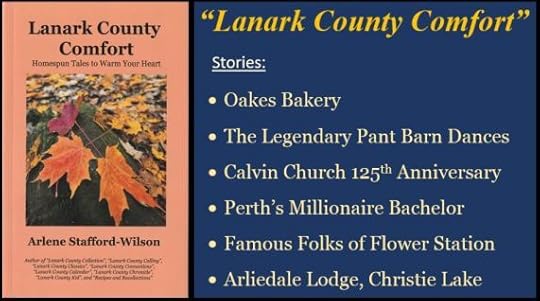 Available :lanarkcountybooks@gmail.com or at The Book Nook, Spark Books https://www.sparkperth.ca/ in Perth, and Mill Street Books https://millstreetbooks.com/, in Almonte.
Available :lanarkcountybooks@gmail.com or at The Book Nook, Spark Books https://www.sparkperth.ca/ in Perth, and Mill Street Books https://millstreetbooks.com/, in Almonte.

Arlene Stafford-Wilson
Member, Association of Professional GenealogistsHonorary Life Member, Lanark County Genealogical SocietyAuthor of : “Lanark County Christmas”, “Lanark County Comfort”, “Lanark County Collection”, “Lanark County Calling”, “Lanark County Classics”, “Lanark County Connections”, “Lanark County Calendar”, “Lanark County Chronicle”, “Lanark County Kid”, & “Recipes & Recollections”available at local stores or email: lanarkcountybooks@gmail.comNovember 23, 2022
Roclyn Mansion, Smiths Falls
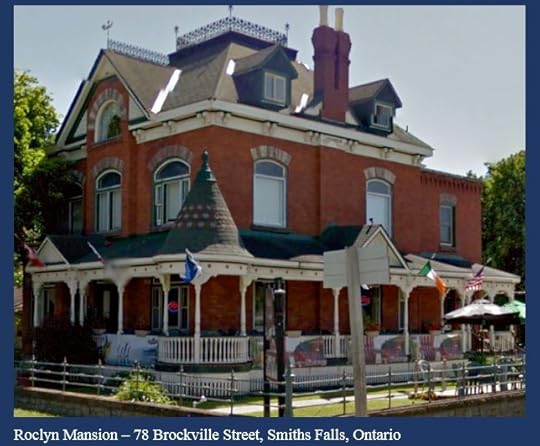
Roclyn Mansion
On a Sunday drive through the town of Smiths Falls, this elegant mansion is difficult to miss. Situated at the intersection of Brockville Street and Lombard Street, we might guess that the original owners, Ogle and Isabella Carss, intentionally built their lavish home in this location for maximum visibility. It appears like a grand and glorious castle, a stately haven of tranquility rising tall and proud amidst the hustle and bustle of passing traffic, honking horns, and the curious stares of passerbys.
Roclyn Mansion is an example of the Queen Anne Revival architectural style, as seen in the multiple sloped roofs, the cast-iron railings, the tower, and the long elegant verandah. Today, we can only wonder what went on behind those tall red brick walls in the early days? Who sat on that spacious sweeping verandah, sipping cool drinks, sheltered from the hot sun, living a life that few could only dream of?
It’s been said that the lady of the house, Isabella, designed the home, working alongside the architects, overseeing many of the particulars of the room dimensions, function of the living spaces, and directing the interior design and decoration. The end result was spacious, elegant, and fit for a prominent wealthy family like theirs. Isabella’s husband, Ogle, was a captain of industry in the town, owner of the Canada Clothing Company, he also operated the steamship, “Olive”, that sailed up and down the Rideau River. He was a respected member of the Smiths Falls Board of Trade, served as Mayor in 1890-91, held the rank of Grand Registrar with the Masonic Order, Town Councillor, local land developer, and was a generous contributer to the funds raised to build the Smiths Falls Hospital.
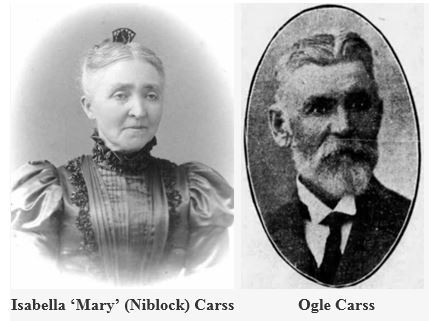
Ogle Carss
Ogle (1846-1925) was born in Phillipsville, a small hamlet south east of Smiths Falls, the son of James Carss, who came from County Wexford, Ireland, and his wife, Alice Wilson, also from Ireland. At the age of 26, Ogle married Isabella Niblock, age 25, (1847-1937), daughter of James Niblock of Belfast, Ireland, and Sarah Ann Foster, of Rosscommon, Ireland. They had four children: Lila, (1873-1968), James, (1875-1934), Ethel (1877-1881), and Henry (1879-1882). Of the four children only Lila and James survived to adulthood. In a diptheria outbreak the two youngest children, Ethel, age 4, passed away two days before Christmas, December 23, 1881, and their youngest, Henry, died three weeks later, on January 13, 1882. At that time there was no treatment nor cure for diptheria.
Lila and George Carss
Lila, like her mother, was gifted musically, and, following in her mother’s footsteps, she became a music teacher.
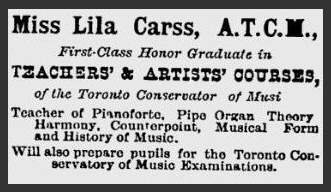
Lila, age 47, moved to Toronto in 1920 with her parents, when Ogle retired from public life at age 74. James, age 45, was already established in a law practice there. Both children remained in Toronto and chose to live out their years there.
“Mr. and Mrs. Ogle Carss and daughter, Miss Lila, left on Thursday for Toronto, where they will in future reside. Mr. and Mrs. Carss were among the oldest and best known residents of Smiths Falls and their removal from town will be regretted by a large circle of friends. They had lived here for more than 40 years, and in all those years Mr. Carss had taken a prominent part in the life of the town. He had served in the coucil, and had been Mayor, and during his residence of two score years was actively interested in many enterprises.”
July 17, 1920, “Ottawa Journal”

Lila and James, 1882

Lila Carss, during her days as a music teacher
Lila continued her career as a music teacher, and after her father’s death, she and her mother, Isabella, lived in a lovely home in the Forest Hill community. On Sunday, November 28, 1937, at her home, 393 Tweedsmuir Avenue, Toronto, Isabella Carss, died in her 91st year. Lila passed away in 1968, at the age of 94.
“Ogle Carss is head of the Canada Clothing Company, one of the long established mercantile concerns of the town. He is one of the town’s substantial citizens, and has been a resident for many years. He has served as Councillor and Mayor, and has been long connected with the Board of Trade.”
Feb. 8, 1913, p. 26, “The Ottawa Citizen”
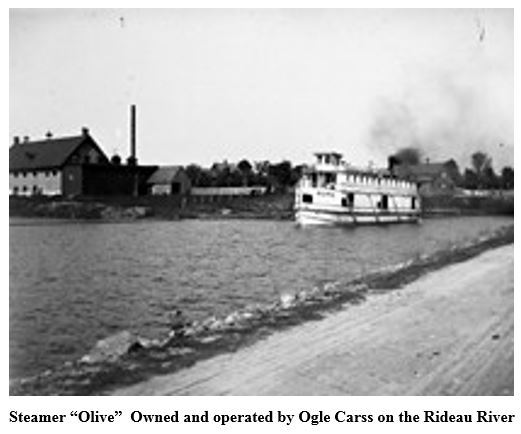
Their son, James Carss
James studied law and became well known in the Toronto legal circles of his time. In 1921, at age 46, one year after his parents and Lila moved to Toronto, he married Mabel Kilner, age 25, daughter of William Kilner and Jemima Carroll.
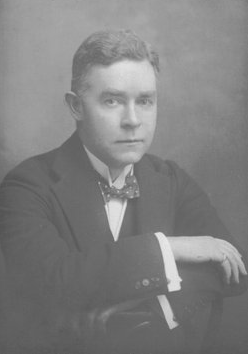
James Ogle Carss
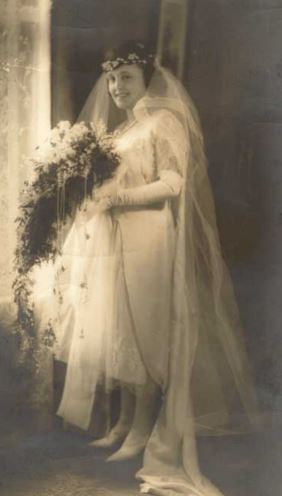
Mabel (Kilner) Carss, on her wedding day, June 1921
James and Mable had three children: Thomas Ogle Carss (1922-2015), Marjorie Kilner Carss (1924-2006), and Carol Isobel Carss (1929-2022)
Building the Mansion
Although some sources say that Ogle and Isabella Carss built their home in 1895, there is an article in the “Almonte Gazette” from August of 1878, which mentions a severe thunderstorm in Smiths Falls, which causes some damage to Ogle’s ‘new house’:
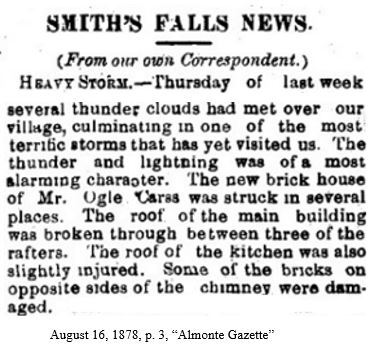
Roclyn Mansion
in the Old Days

Ogle and Isabella Carss’ mansion, Roclyn, in the early days
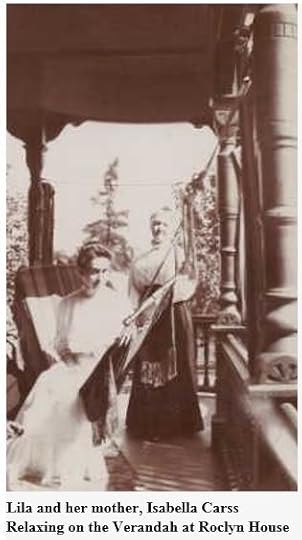
Roclyn Mansion
in Modern Times
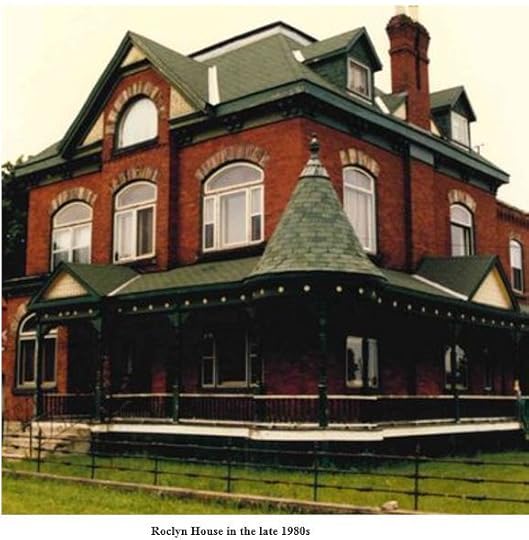
In the fall of 1992, well-known local artist, Ben Babelowsky, (1932-2019) captured the splendour of the grand old Roclyn House in Smiths Falls. At that time, it had been converted to a restaurant and was known as the ‘Roclyn Roast Beef House’.
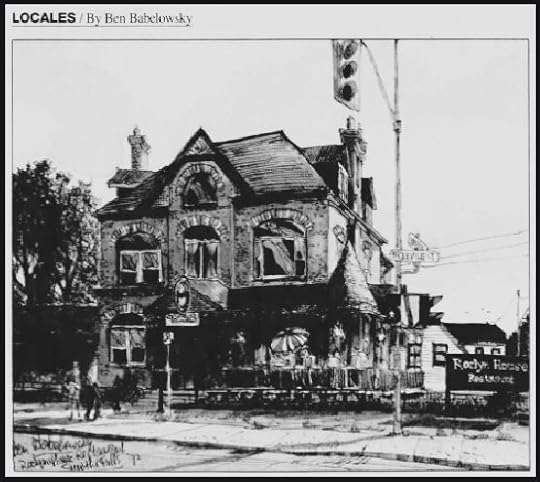

Oct. 18, 1992, p. 33, “The Ottawa Citizen”
Kilt and Castle
Another restaurant opened in Roclyn House, called the “Kilt and Castle”, and after it closed, the building was purchased in 2017 by Lisa McLean, with the intention of converting the property to a bed and breakfast.
In an article on Roclyn House, published in the Smiths Falls Record News, “Inside Ottawa Valley”, April 11, 2018:
“According to a town report presented to council’s committee April 9, 2018 the property is in a state of disrepair, and currently unusable.
The new owners are in the midst of repairs and renovations that they hope will be completed by August 2018.“
(The owners were applying to the town of Smiths Falls for a reduced tax rate while the building wasn’t fit for habitation, with the understanding that the property taxes would be reinstated after the house was deemed safe for occupancy.)
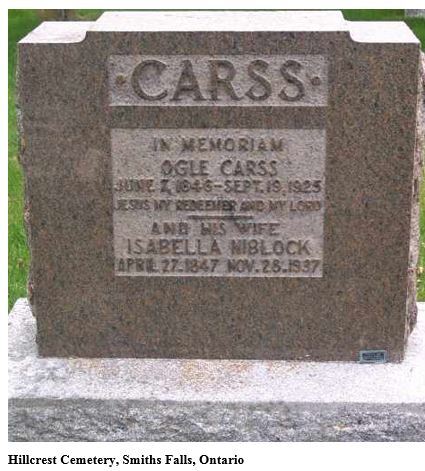
Restoration?
Will the Roclyn Mansion ever be restored to her former glory? Will another family enjoy cool drinks and a warm summer breeze on the verandah like socialte Isabella Carss and her lovely daughter, Lila? Will the house once again be filled with the sounds of music as it was in the early days when Lila taught music to her eager students, while Isabella looked on with pride?

We can only imagine the glory days of Roclyn House, when this prominent Smiths Falls family graced the rooms and hallways, entertained prominent members of the local politcal and social community, and gazed out from their lofty perch on the top floor, of this very special architectural gem.
*************************
sources: news clippings – various – “Almonte Gazette”, “Ottawa Journal”, Ottawa Citizen”, “Inside Ottawa Valley”, Carss family photos: Ancestry.com. Public Member Photos & Scanned Documents, other photos: Library & Archives Canada – public domain.
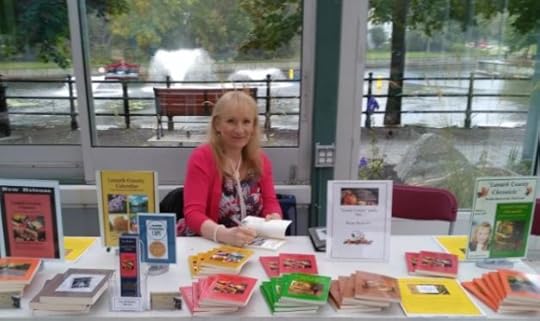
Arlene Stafford-Wilson
Member, Association of Professional Genealogists
Honorary Life Member, Lanark County Genealogical Society
Author of : “Lanark County Christmas”, “Lanark County Comfort”, “Lanark County Collection”, “Lanark County Calling”, “Lanark County Classics”, “Lanark County Connections”, “Lanark County Calendar”, “Lanark County Chronicle”, “Lanark County Kid”, & “Recipes & Recollections”
available at local stores or email: lanarkcountybooks@gmail.com
November 22, 2022
Time for Christmas Baking!
“I think a little mouse has been in my cupboard!”, Mother would say mischievously. Of course I knew exactly who the ‘mouse’ or ‘mice’ were that had been sampling the baking supplies in the kitchen cupboard, above the old porcelain sink. I was the ‘main’ mouse, and loved to sneak a little taste of the walnuts, coconut, and cherries, that Mother stored for her Christmas baking. My brother, Roger, was the other mouse in the house. He would sneak handfuls of chocolate chips from her baking cupboard after school, and scurry away into the living room.



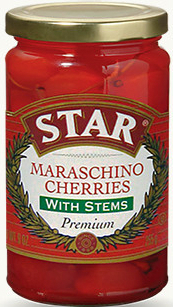
Luckily, on those days, so long ago, there were still enough ingredients so Mother could add yet another type of cookie onto her list, and into the oven!


Stacks of cookies and squares had been accumulating in the old chest freezer since the cooler fall air blew in from the north, along the Third Line.


Mother was knee-deep into her Christmas baking, and as the weeks flew by, there was an ever-growing supply of shortbread, sugar cookies, chocolate chews, date squares, fudge, and toffee, piling up, in preparation for the big day.

One of my favourite types of cookies that Mother made, and tucked away in the freezer for Christmas, were the peanut butter balls. Once thawed, they were as sweet and tasty as the day they were made. They don’t require a lot of fancy ingredients, and they look festive and elegant on any Christmas dessert plate.
Make them now, and stash them in your freezer! Hopefully, the ‘mice’ in your house will leave a few for Christmas!
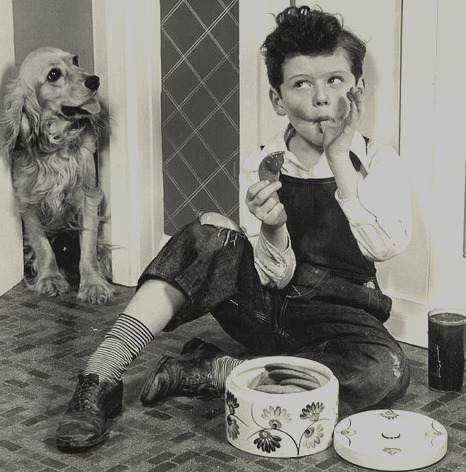
1 c of peanut butter
1 c of rice crispies
½ c chopped walnuts
1 tsp vanilla
½ tsp of melted butter
1 c icing sugar
Desiccated coconut
Mix together the peanut butter, nuts, rice crispies, butter and vanilla, and roll into balls.
Drop the balls into a mixture of thin icing
Roll in coconut
Place on a sheet of waxed paper, and let them set
…
For variety, Peanut Butter Balls may be dipped in melted chocolate, mixed with sprinkles, M & Ms, or decorated with bits of pretzels and candies for a festive holiday look!




Enjoy this traditional Christmas treat now, or freeze for the holidays!
…

Mother’s Farmhouse Shortbread
What would a Christmas sweets plate be without some melt-in-your-mouth homemade Shortbread Cookies!

1/2 c corn starch
1/2 c icing sugar
1 c all purpose flour
1 c soft butter
Mix dry ingredients. Blend-in butter, until soft dough is formed. Chill for 1/2 hour. Shape into balls 1 inch in diameter. Flatten with fork. Decorate with cherry slices.
Bake in slow oven at 300 degrees F, for 20 – 25 minutes, until light golden.
…………………………………………………………………………………………………………………..
Be sure to leave some Christmas cookies for Santa!

Audry Stafford competed in local fairs in Lanark County for many decades, and won so many prizes in the baking divisions that eventually she was asked to become a Judge.
In the years that followed, she judged baking at fairs, large and small, across the county, and throughout Eastern Ontario.

……………
Bake something special for your friends and family this Christmas season, for some crowd-pleasing treats, and some wonderful Christmas memories! A small tin of your homemade cookies makes a low-cost gift, and will be cherished by friends because it comes from the heart.Recipes in this story are from “Recipes and Recollections: Treats and Tales from our Mother’s Kitchen”93 of Audry’s prize-winning recipes are assembled in a book “Recipes and Recollections”, along with stories from her five children, about growing up in rural Eastern Ontario, spanning the years from the 1940s through to the 1980s.Photo on cover of “Recipes and Recollections” – Tim Stafford and Judy Stafford, 1947 (background – Audry Stafford’s handwritten recipe)…………………………………………

*****

Arlene Stafford-Wilson
Member, Association of Professional Genealogists
Honorary Life Member, Lanark County Genealogical Society
Author of : “Lanark County Christmas”, “Lanark County Comfort”, “Lanark County Collection”, “Lanark County Calling”, “Lanark County Classics”, “Lanark County Connections”, “Lanark County Calendar”, “Lanark County Chronicle”, “Lanark County Kid”, & “Recipes & Recollections”
available at local stores or email: lanarkcountybooks@gmail.com
November 20, 2022
Haggis Candy – Goodies on Gore Street!
It was her father, James Haggis, who started the candy business in Perth, back in 1926, but it will likely be Sophia, who will always be remembered fondly, as the ‘Candy Lady’.

Sophia used the original equipment, passed down to her, from her father, like the big copper pots for melting rich, velvety, chocolate, and buttery peanut brittle.


Each year at Easter, Sophia made delicious chocolate bunnies and eggs, and would offer to personalize them with any name. She used a stiff white icing, and piped on the names by hand, as her eager audiences waited for their special egg to be completed.


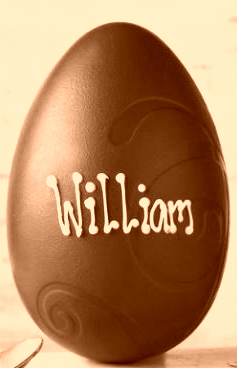
Haggis Candy was located on the main street of Perth, at 60 Gore St. E.

A very special time of year for Haggis Candy was Christmas, and Sophia decorated her store windows with her giant candy-canes, some of them almost six feet tall!

One of Sophia’s specialties was her Horehound candy. It had a very distinctive flavour, and some said that it was a good remedy for sore throats, and congestion. Most of her customers just liked its unique taste. People came from miles around to buy her Horehound.

Sophia made her candy from the Horehound Plant. The plants are picked, dried, and steeped with boiling water. The liquid is strained, sugar is added and brought to a boil, then cooled on a marble slab. The finished candies are cut into squares, and rolled in powdered sugar.

Another customer favourite was Haggis’ taffy. Sophia used the original steel hooks to pull her taffy, to just the right consistency.

…..and the finished taffy, ready to enjoy!

She used the marble slabs, passed down from her father, to cool her fudge quickly, so that it could be cut into squares.
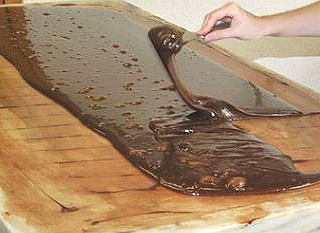

Sophia had a quick smile, and a warm personality. She loved following in the traditions of her father, and most of all loved to see the smiles on her customer’s faces when they tasted her delicious treats.

Haggis’ Candy store was where you’d often find my friends and I, after leaving Perth High School in the late afternoon. My personal favourites were Sophia’s milk chocolate peanut clusters, made with real Spanish peanuts! Sophia would place a few in a small, brown-paper bag, weigh them, and hand them to me with a smile. Sometimes I would bring them outside, walk down Gore Street, sit on the bridge, and watch the world go by, as I savoured my chocolate treats!

On hot, muggy, summer days, Sophia made the most delicious banana splits, and often tourists and locals alike, would stop by her store to sample some of her rich, creamy, creations.

In 1988, at the age of 77, Sophia retired from the candy business. She kept active in her later years, and continued to play the piano, as she had often done, at various events in Perth, over the years.

Sophia eventually left Perth, and moved to Kingston. She lived a long life, and there were many very happy birthdays over the years!
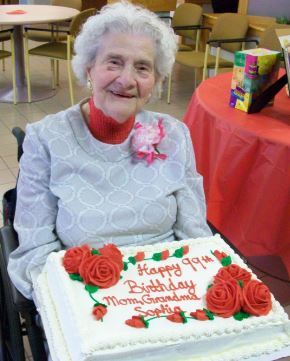
Sophia had a wonderful milestone birthday, when she celebrated her 100th! She still had her kind smile, and bright eyes.

After a long, happy, life, Sophia passed away at Providence Manor in Kingston, on Sunday, November 4th, 2012, at the age of 101.
She may be gone, but never forgotten, and many of us will treasure the memories of our childhood visits to Haggis’ Candy store.
She will always be fondly remembered as the ‘Candy Lady of Perth’.
………………
Read the fascinating story of Sophia Haggis Nee in “Lanark County Calling: All Roads Lead Home”. Learn about Sophia’s childhood in Peterborough, her grandfather the Lockmaster on the Trent Canal, her grandmother Sarah, the published Poet, and find out about her great uncle Samuel Lowry and his scandalous court case. Read about her days as a teenager at the Perth High School, and her chance meeting with the influential Mrs. Jack Stewart. Learn about Sophia’s most unusual trail-blazing career in Kingston, Ontario, before moving back to Perth to take over her ailing father’s business. Read memories of the happy days at the candy store, the customers, the ‘regulars’, and some surprising things about this much-loved lady and well-respected woman entrepreneur in the town of Perth, Ontario.

Arlene Stafford-Wilson
Member, Association of Professional GenealogistsHonorary Life Member, Lanark County Genealogical SocietyAuthor of : “Lanark County Christmas”, “Lanark County Comfort”, “Lanark County Collection”, “Lanark County Calling”, “Lanark County Classics”, “Lanark County Connections”, “Lanark County Calendar”, “Lanark County Chronicle”, “Lanark County Kid”, & “Recipes & Recollections”available at local stores or email: lanarkcountybooks@gmail.comNovember 16, 2022
First Snowfall of the Season
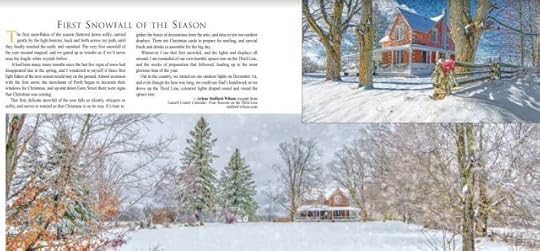
The first snowflakes of the season fluttered down softly, carried gently by the light breezes, back and forth across my path, until they finally touched the earth, and vanished. The very first snowfall of the year seemed magical, and we gazed up in wonder as if we’d never seen the fragile white crystals before.
It had been many, many months since the last few signs of snow had disappeared late in the spring, and I wondered to myself if these first light flakes of the new season would stay on the ground. Almost in unison with the first snow, the merchants of Perth began to decorate their windows for Christmas, and up and down Gore Street there were signs that Christmas was coming.

James Brothers, Stedman’s, and Beamish had bright lights and shiny garlands in their windows, and Shaw’s always had a festive window display.
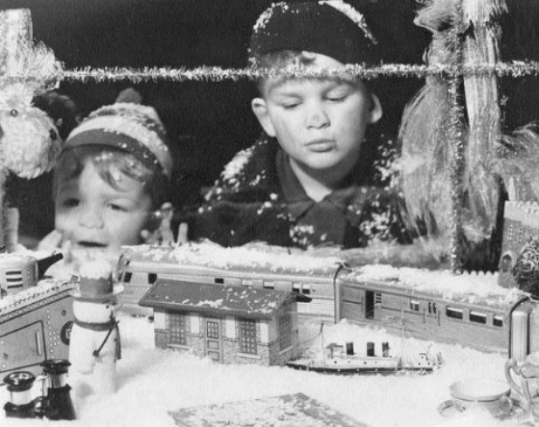


A walk down to Haggis’ candy store was not to be missed, as Mrs. Nee’s colourful candy canes, creamy Christmas fudge, and salty nuts were temptingly displayed.

The Perth Apothecary always had a beautiful Christmas window with all of their lotions and potions packaged so beautifully, ready to place under the tree.



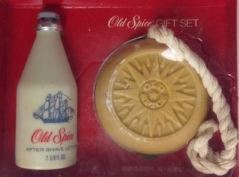

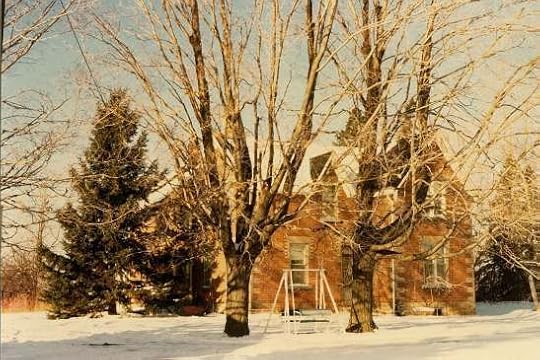
The signs of the season weren’t visible only in the town of Perth. The first snowfall in the country meant bringing out our sleds, our flying saucers, and our winter toys!

Out in the country, we turned on our outdoor lights on December 1st, and even though the lane was long, we could see Dad’s handiwork as we drove up the Third Line, coloured lights draped round and round the spruce tree.
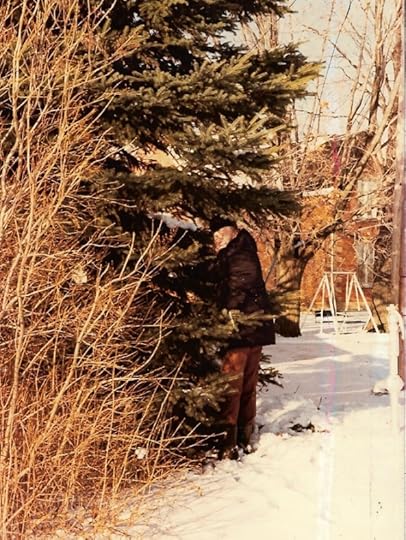
Dad took great pride in his annual Christmas display, though it was a far cry from the elaborate decorations on the more stately homes in Perth. It’s strange how, as a child, the lights on your own home, no matter how modest; seem brighter, and more magical than all the rest.

That first, delicate snowfall of the year falls so silently, whispers so softly, and serves to remind us that Christmas is on its way. It’s time to gather the boxes of decorations from the attic, and time to test our outdoor displays. There are Christmas cards to prepare for mailing, and special foods and drinks to assemble for the big day.
Whenever I see that first snowfall, and the lights and displays all around, I am reminded of our own humble spruce tree on the Third Line, and the weeks of preparation that followed, leading up to the most glorious time of the year.
……….

 Arlene Stafford-Wilson at the creek, where we skated as children, in the lowlands behind the Stafford house.………………………………………………………………………………………………………………http://www.staffordwilson.com“First Snowfall of the Year”, an excerpt from ‘Lanark County Calendar: Four Seasons on the Third Line” ISBN 978-0-9877026-30
Arlene Stafford-Wilson at the creek, where we skated as children, in the lowlands behind the Stafford house.………………………………………………………………………………………………………………http://www.staffordwilson.com“First Snowfall of the Year”, an excerpt from ‘Lanark County Calendar: Four Seasons on the Third Line” ISBN 978-0-9877026-30

Photo of the Stafford house from John McQuarrie’s book, “Perth: Spirit of Place”
At the Book Launch for “Lanark County Calendar”
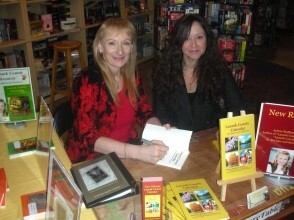
“This memoir by Arlene Stafford-Wilson is, to paraphrase the poet Keats, ‘a thing of beauty and a joy forever.’ This is my favourite among the books by this author. Her latest memories of a happy childhood spent on the Third Line of Lanark County’s Bathurst Township are sure to please her host of fans.
The book has its appeal on several levels. Schoolchildren will enjoy Arlene’s accounts of what it was like to be a child in the in the not-so- olden days, especially if the book is read to them by a teacher or grandparent. How will today’s youngsters view a little girl who played with a skipping rope, enjoyed board games with the family, and waxed autumn leaves to preserve their colour, with never a computer in sight? And how many may have heard the lonesome sound of a train whistle. or have woken up on a winter morning to find their drinking water turned to ice beside the bed?
Any child will surely understand the author’s dismay at being scammed by a carnie at the fair, after investing a whole two dollars in a game of skill designed to cheat the customer. Some things never change.
Present and former residents of Bathurst who find themselves mentioned in the book will no doubt set off on their personal trip down memory lane as a result. Who knows? The thrill of discovery may encourage them to record their own memories for posterity and we shall all be the richer for it.
As for me, I found myself identifying with Arlene’s Mother, who occupies a special place in the author’s heart. I was a country wife and mother in Lanark County in that same era and Mrs. Stafford’s daily round was familiar to me. Cooking, cleaning, baking, washing, ironing, gardening, making jam, maple syrup, pickles and preserves. Sewing, knitting, mending. Entering home craft articles in the fall fair. Working to make Christmas a magical time for the family and filling in for the Easter Bunny. Most of all, trying to make a quarter do the work of a dollar.
The author gives us a glimpse into a vanished era. When did you last attend church on Easter Sunday complete with white gloves and, if you were lucky, a new hat? Your mouth will water when you read about the wonderful homemade treats produced by Bathurst Township housewives for the delight of small ghosts and goblins at Hallowe’en. Nobody worried back then that the offerings might be tampered with, and what fun the youngsters had while contriving costumes from whatever materials that came to hand. No child in those days dreamed of wearing expensive store-bought outfits that would be abandoned after one evening’s wear. Modern-day parents could learn a thing or two from reading this book.
And who can forget the delight of cleaning the batter from the baking bowl when something delectable was being prepared for the oven, as the author did? Back then nobody worried about getting salmonella poisoning from raw eggs and somehow we all survived the experience.
Lanark County Calendar: Four Seasons on the Third Line is definitely a book for everyone. When you reach page 136 you will find yourself looking forward with pleasurable anticipation to the next book in the series.
In the meantime, as Arlene says, ‘We need only to close our eyes and we are back on the Third Line, walking up the lane, through the yard and entering the bright, warm kitchen. We are home again.”
Book review written by Carol McCuaig November 11, 2013

………..

Arlene Stafford-Wilson
Member, Association of Professional GenealogistsHonorary Life Member, Lanark County Genealogical SocietyAuthor of : “Lanark County Christmas”, “Lanark County Comfort”, “Lanark County Collection”, “Lanark County Calling”, “Lanark County Classics”, “Lanark County Connections”, “Lanark County Calendar”, “Lanark County Chronicle”, “Lanark County Kid”, & “Recipes & Recollections”Books available at:The Book Nook & Other Treasures, and Spark Curios and Books, in Perth, and Mill Street Books in Almonte, and email: lanarkcountybooks@gmail.comNovember 15, 2022
Grey November Skies
It was one of those mornings in the late fall, when the sky was so grey that you couldn’t tell whether it was daylight, or still dark outside. Halloween was over for another year, and the snow hadn’t begun for the season, to remind us that Christmas was coming. It was just one of those four or five dark, grey, lifeless weeks in between the colourful fall, and the bright snowy winter, when Mother Nature didn’t seem to know what to do.

I headed downstairs that Saturday morning, and took a quick look at the clock on the kitchen wall. With the sky so overcast, I couldn’t even guess what time it was, and I didn’t have a clock in my bedroom upstairs. All I knew was the weekend was here, so I didn’t have to go back to Glen Tay School for another two days.
The whole house seemed gloomy. When I got to the bottom of the stairs, and opened the door, the living room was empty. Where was everybody?

The only room that seemed to be lit up in the old house was the kitchen, and as I walked through the living room, and got close enough to see, Mother was in full production, as usual.
Audry (Rutherford) Stafford in her kitchen, 3rd Line of Bathurst Township, Lanark CountyShe had the old aluminum meat grinder attached to the kitchen table, and had bags of flour and sugar, and boxes of baking soda and baking powder lined up along the edge.

There were packages of raisins and candied pineapple, and currants and cherries, all over the top of the freezer, as though they were waiting their turn to go into the huge white ceramic mixing bowl. It looked as though some kind of dried fruit was making its way through the meat grinder, and dropping into one of the melamine bowls waiting below.

“Can you run down to Cavanagh’s, and pick up some molasses for me?”, she said without looking up from the meat grinder. “I forgot to pick some up at the IGA last night, and I’ll need some for the Christmas cake.”
“Sure.”, I said, and picked up the three quarters that were already sitting there waiting for me, at the end of the table.

I grabbed my blue corduroy jacket off of the hook, and headed outside. As soon as I opened the door the cold air hit me, and I remembered how the weather had been getting cooler and cooler these past weeks. It felt cold enough to snow, I thought to myself, and I picked up my old, red, battered bike, still lying on the same spot where I’d left it in the yard, the night before.

Brrr. It felt even colder once I was on the bike and moving. The lane was downhill, and I coasted all the way onto the Third Line. I had a quick check for cars, and turned right, still coasting for a bit, then I began to pedal. Ugh, Heney’s dogs!, I thought. I needed a newer, faster bike, or a car, or a spaceship; something to get me past Heney’s faster.
As soon as I saw Conboy’s house, I pedaled like mad. I should have eaten breakfast first, I thought. I could use some energy.
I made it past Heney’s unscathed. They didn’t even come out barking that day. They must have been feeding them or something, I thought. Whew! That was easy.
I was moving pretty fast, and made it to Cavanagh’s in no time. Helen was working, and she pointed out the molasses, and asked how everyone was doing, just like she always did.
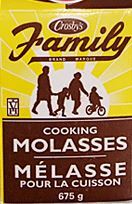
I paid for the molasses, and picked up my bike where I’d left it; propped up against the front entrance of the store.

Since it was Saturday, I decided that I’d take the long way home. I just didn’t feel like riding past Heney’s again and was sure those dogs would be back out on the road, full of food now, and ready to chase me up the Third Line.
I crossed the road and headed up Cameron’s side road. I passed S.S.# 4 school, and was heading up toward Calvin Church.
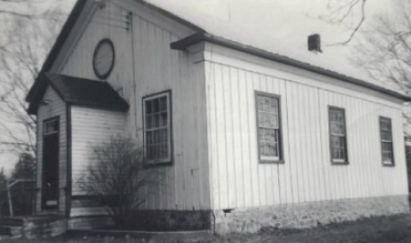
This part of the trip was a bit harder, as it was uphill all the way.

I passed the church, then up the road a bit more, and turned right onto the Fourth Line. It wasn’t long until I was down near Calvin and Marion Jordan’s place, and I slowed down a bit, as I rounded the corner, and headed toward the railroad tracks.

I glanced down into the ditches and spots where I could usually find some flowers to bring home for Mother, but there was no colour in the ditches that day, and even the cattails had gone to seed in the swamp and looked dirty,white and furry. I didn’t see anything worth bringing home for a bouquet.

When I finally arrived back in the yard, I threw down my bike, and walked into the kitchen. I could smell the cake batter as soon as I opened the door. The batter for the Christmas Cake was pinkish. I’m not sure why it was that colour; maybe it was juice from the cherries. Mother had saved the bowl for me to clean, and it was sitting on the edge of the table. Mother said she would add the molasses in with the ground fruit, and that sure worked for me. I loved cleaning out the cake batter bowls. This was my kind of breakfast!

I’m not sure why the Christmas Cake had to be made so early. Mother said it had to ‘ripen’ and I was never really sure what she meant by that. It wasn’t like a green banana, or one of the green apples from back in the orchard. Still, it was part of the process of making the cake each year, and there was no point in arguing.

No matter what the reason for making the Christmas Cake in what seemed like the drabbest, dreariest part of the year, I liked to think of it as kind of a light at the end of a tunnel. It was so grey and colourless outside. The bright leaves were lying, lifeless on the ground. The birds had left the yard. I couldn’t find one bright, pretty flower to bring Mother for a bouquet; not even a cattail. Nature seemed to be in limbo; not sure what to do next.
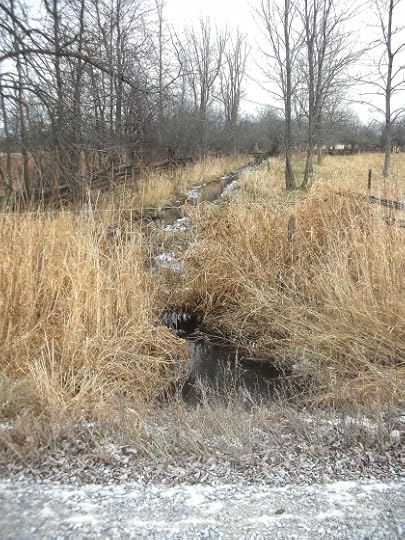
Making the Christmas cake was the first sign that the brightest season of the year was on its way. In just a matter of weeks we’d be celebrating Christmas. Bit by bit, in the days ahead, we’d be making progress on our preparations. The Christmas cards would be signed and addressed. Betty Miller and Frances Dixon would begin organizing the Christmas concert at Calvin Church, and we’d all have our parts to study, and new songs to learn.
Dad would be stringing the Christmas lights on the big spruce tree near the house, any day now. Soon, we would be strolling back into the bush to size up the possible candidates for the Christmas tree, that would grace the corner of our living room.
Before too long, pans of fudge would be prepared, and all sorts of cookies and squares would be baked and stored. Crepe paper streamers would be brought out of storage, and old decorations glued and repaired.
So the grey days, I concluded to myself, were days of preparation. These were the days when we would have time to spend getting ready for Christmas. They were the days when we wouldn’t be distracted by the bright sun, and green grass, to go outside and play, but would stay indoors, and stroke things off of our to-do lists.
In its wisdom, Nature had given us quiet, thoughtful days like these,to focus on the things to come, because Christmas would be upon us in no time at all.
……………………………………………
Granny Rutherford’s Dark Fruit Cake(should be baked a few weeks ahead, and allowed to ripen before Christmas)2 cups raisins
1 1/2 cups of cherries
1 cup currants
1 cup dates
1 1/2 tsp cinnamon
1 1/2 cups seeded raisins
1 cup pecans
1 1/2 cups mixed dried fruit
1/2 cup candied pineapple
1/4 tsp. mace
1/2 tsp. ginger
1/2 tsp nutmeg
1 tsp salt
3 cups flour
1 cup butter
1 1/2 tsp baking powder
1 1/4 cup brown sugar
1/4 tsp cloves
6 eggs
1/2 cup molasses
1/3 cup cold coffee
Mix fruit and nuts (may grind coarse or fine, as desired)
sift flour and spices and mix well
cream butter, and add sugar and eggs
Add dry ingredients
Bake at 300 degrees for 3 – 3 1/2 hours
………..
Allow to cool on baking racks
(double-wrap in plastic, then double-wrap in foil, and store in a cool dry place to ripen)…………
Who was Granny Rutherford?Dorothy Woolsey, born in Lincolnshire, England, was just sixteen years old when her mother Mary-Jane Foster Woolsey, passed away. She often told the story of how they dyed her favourite red coat – black for her mother’s funeral. In 1909 her father, William Woolsey, brought Dorothy and her siblings over to Canada, because his eldest daughter, Edith, had weak lungs, and the doctor advised him the air in Canada would be better for her.
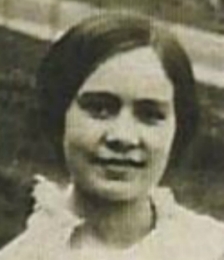
They settled first in Winnipeg, and Dorothy’s older sister Florence, married, and moved to Saskatoon. Dorothy went to visit, and she met a handsome young man named Charles Rutherford, a Mechanical Engineer, who came to Canada from St. Lawrence County, New York, to seek his fortune. Dorothy and Charles fell in love, married, and settled in Edmonton, where their children Dorothea ‘Dolly’, Mildred ‘Mill’, Audry, Muriel, and Jack were born.
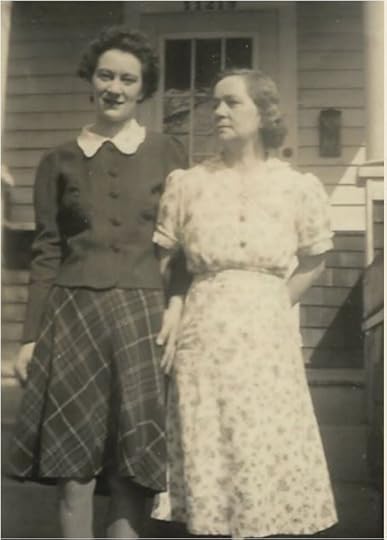
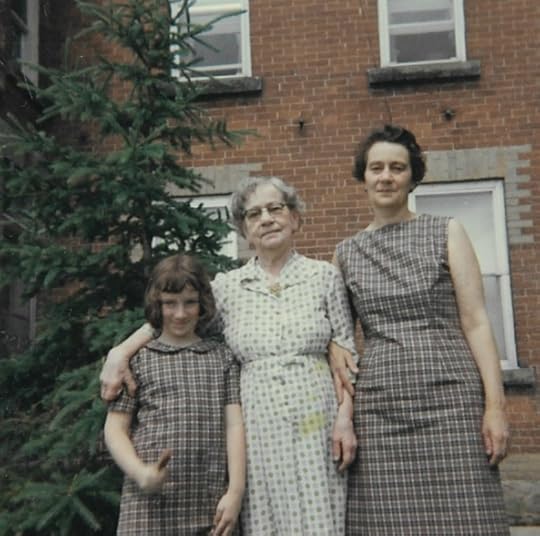
…………………………………………………………………….
Christmas Cake recipe – in “Recipes and Recollections – Treats and Tales From Our Mother’s Kitchen, available in local stores or online. ISBN 978-0-9877026-0-9
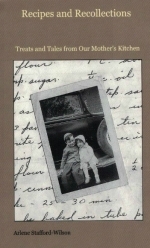
Arlene Stafford-Wilson
Member, Association of Professional GenealogistsHonorary Life Member, Lanark County Genealogical SocietyAuthor of : “Lanark County Christmas”, “Lanark County Comfort”, “Lanark County Collection”, “Lanark County Calling”, “Lanark County Classics”, “Lanark County Connections”, “Lanark County Calendar”, “Lanark County Chronicle”, “Lanark County Kid”, & “Recipes & Recollections”available at local stores or email: lanarkcountybooks@gmail.comNovember 10, 2022
Finding Our WWI Ancestors
Short days ago we lived,
felt dawn, saw sunset glow,
loved and were loved,
and now we lie in Flanders Fields.” — John McCrae
Over 600,000 men and women enlisted in the Canadian Expeditionary Force (CEF) during the First World War, (1914-1918) as soldiers, nurses and chaplains. The CEF database is an index to those service files, which are held by Library and Archives Canada.
This free online searchable database includes over 600,000 men and women who participated in WWI (1914-1918) including soldiers as well as nurses and clergy:
WWI Canadian Forces Personnel Records
These service files contain the name, address, service number, name of the next of kin, their physical description , skin colour, eye colour and scars or identifiable markings, and the unit number and location where they signed up for service.
On this site you can find links to the soldier’s file, which contain medical and pay records, and encompass a more detailed personal history of the soldier, and includes the specific units where they served, after going overseas. The soldier’s full service records are not available online, however, they may be ordered for a fee from Library and Archives Canada.
Also available are links to the Canadian Virtual War Memorial if the soldier died while in service.
War Diaries – This is a link to the diaries of the unit, not to personal diaries, but of the records of day to day life in a particular unit. This will give you great insight to how your ancestor lived in times of war in their group as they trekked across Europe and participated in various battles – some successful and some not.
Using the resources and links mentioned in this article, I was able to search and locate cousin Harry Stafford’s enlistment papers, his detailed medical files, including x-ray images and comments from attending physicians, his pay statements, physical description, and name and address of his next of kin.
I was also able to find out about the specific battle where he was wounded and subsequent hospitals in Europe where he received treatment. The records also state his date and condition at discharge, and pay records of any amount owing.
Harry’s story begins with the 130th Battalion, Lanark and Renfrew Scottish Regiment which was the ‘130th also known as the ‘overseas’ Battalion, based in Perth, Ontario.
They began recruiting in the fall of 1915, in Lanark and Renfrew Counties.
Harry’s StoryNine-year old Harry stood by the shore, and watched in horror as his eldest brother Wilfred struggled to the surface again and again, until he finally slipped out of sight into the deep blue waters of the Mississippi River near Lanark.
Harry and his brothers often played near the water, although none of them could swim. The four brothers stood on the shore that fateful day in July, and skipped stones on the surface of the water, just as they had so many times before.
Wilfred, two days shy of his thirteenth birthday, was the eldest of the four. He took great pride in showing his younger brothers how to pick the longest flattest stones. He coached them on how to hold the stones on their flat side, and throw them parallel to the water, so they would skip farther along the waves. Dick, at age ten, was beginning to get the hang of it. Harry and his twin brother Frank had turned nine two months before and were doing their best to keep up with the older boys.
Harry, the stronger and more athletic of the twins was trying to help his brother Frank as he struggled with the task. Frank had kyphosis which meant that he had a severe curvature of the spine. People in those days referred to Frank as a ‘hunchback’, but he was still able to do most things; although it might take him a little longer.
One of the boys had thrown his prized pocket-knife into the water by mistake, and Wilfred had gone into the water to retrieve it, slipped on a rock and fell into a deep hole, unable to swim, and drowned. The younger boys had raced back into Lanark to get help, but it was too late. By the time they had met up with the first grown-up it was already after five. Mr. Baker, the local tailor in Lanark hurried back to the spot, and pulled Wilfred’s lifeless body from the river.
Mr. Baker laid the body gently on the shore, and headed back to the Stafford home to deliver the news. Harry’s mother Mary (Murphy) Stafford was pregnant with her next child Carmel at that time, and both she and Harry’s father Peter were overcome with grief.
This would be Harry’s first, though not his last encounter with death at a young age. Two years later in the spring, his mother once again gave birth to twins – this time a boy and a girl – Rose Marie and Martin Wilfred, named for his late brother. The twins were born in the spring, and Harry’s parents were delighted to welcome the new babies into their growing family. Sadly, tragedy struck once again, and Harry’s new little brother Martin Wilfred, the weaker of the two passed away quietly, just seven weeks after his birth.
A few short years after the second tragic event in Harry’s family, war was declared in Europe. Canada was still under British rule at the time and as such would be expected to join in the war efforts overseas.
Within the next couple of years tales of the excitement and adventure on the front lines travelled back to Perth, and acts of heroism and valour were recounted in the local papers. Life on the farm, and the daily chores seemed mundane, compared with the glorified life of a soldier fighting for freedom.
The 130th Battalion, Lanark and Renfrew Scottish Regiment which was the ‘130th “Overseas” Battalion, CEF’ Based in Perth, Ontario, began recruiting in the fall of 1915 in Lanark and Renfrew Counties. When a recruitment officer arrived in the village of Lanark one winter, young Harry, just sixteen at the time lied about his age and signed up on the spot.
The Canadian Expeditionary Forces, as they were known, specifically recruited men between the ages of 18 and 45, so Harry claimed that he was born the same year as his brother Dick and was actually eighteen years old. They took him at his word, and Harry became an enlisted man on January 9th, 1916.
Harry, along with some local lads, was sent for basic training in Valcartier, Quebec and returned home for a brief visit before going overseas.
August 4 1916 – ‘The Perth Courier’“Corporals Ronald Scott, William Strang and Jack Scott (McDonald’s Corners) and Privates Lance Affleck, Ralph Craig, John Kingston, Harry Stafford, Henry Barrie (Watson’s Corners), and Joseph Bennett (Fallbrook) of the 130th Batt., Valcartier, are home on a week’s furlough – their farewell visit before going overseas.” (Harry was 17 by then)
The 130th Battalion left the Halifax harbour and sailed for Britain on 23 September 1916. After two weeks at sea, arriving in Liverpool, England on October 6th, Harry and the other members of the unit were absorbed by the ’12th Reserve Battalion, CEF. Their prime function was to provide reinforcements for the Canadian Corps that were already fighting in the field.
After fighting bravely in both England and France, Harry found himself participating in one of the most significant campaigns in WWI. Known as the Third Battle of Ypres (or Passchendaele) this battle was remembered both for its tremendous loss of life and casualties and because of the horrendous conditions of the battlefield.
The siege of Passchendaele went on for over three months from July through November 1917. More than 4,000 Canadians died and over 12,000 were wounded. The battlefield consisted of flat, swampy lowlands, and when heavy rainfall pounded the fields that autumn, the ground became a sea of mud. The men had to struggle through the thick mud with very little cover, while German soldiers tore them to pieces with their machine guns.
By November the Canadians were finally beginning to win the battle and began to push the Germans back from their stronghold. It was on the 6th day of November 1917 that 18 year old Harry was wounded in the leg by German gunfire at Passchendaele.
Harry was dragged out of the line of fire, received basic care from one of the medics to stop the bleeding and was sent to a hospital in England. He was admitted two days later on November 8th.
Word of Harry’s injuries was sent to his parents, back on the farm, in Lanark:” Mr. and Mrs. Peter Stafford received a telegraph from the Director of Records, Ottawa, on Friday, informing them that their son, Pte. Harry Stafford, 787104, had been wounded by gunshot in thigh and leg on Nov 6th, and admitted to No. 6 Field Ambulance Depot. Harry went overseas with the 130th Batt. in September, 1916, was transferred to another battalion for service in France, and has been through some severe engagements since crossing the channel. His many friends hope that Harry’s wounds are not serious.”
—-21 November, 1917, “The Lanark Era”The medical care during WWI was a very complex set of institutions, which cared for wounded soldiers from the battlefield, as soon after injury as possible. The soldier was evacuated as quickly as possible for treatment, and provided care.
The Field Ambulance was a mobile unit equipped with horse-drawn ambulances. They brought soldiers from the battlefields to an Advanced Dressing Station located at the rear of the siege out of harm’s way.
After Harry was shot, the first day he was sent to the #6 Field Ambulance Nov 6 1917, and after a month’s time was transferred to the Pavilion General Hospital Brighton Nov 23 1917, for three weeks.
Harry’s condition was not improving, and he suffered infection after infection. He was transferred to the Military Convalescent Hospital at Woodcote Park, Epsom, England on Dec 22, 1917 and he remained there receiving treatment for four and a half months.
In March 1918 he was transferred to Bramshott Military Hospital, where he was treated for one month, with still no sign of improvement.
It was during this time that Harry received word from his parents at home that his brother Carl had enlisted in a month earlier, and like Harry had lied about his age in order to join the service.
On July 8th, 1918 Harry was admitted to the Granville Canadian Special Hospital in Buxton, Derbyshire, England.
In November of 1918 WW1 finally ended. Losses of human life by Canadians and the allies were in the thousands.
After six months of unsuccessful treatment at the Granville Hospital in England Harry was finally discharged on December 3rd, 1918.
His condition continued to deteriorate, and on December 23 1918 Harry embarked for Canada sailing on the S.S. Tunisian.
Due to his medical condition, Harry was discharged from the military at Ottawa, on February 5, 1919.
Jan 10 1919 Perth Courier:“Pte. Harry Stafford, son of Mr. and Mrs. Peter Stafford, Lanark, returned home Monday from overseas. He went overseas with the 130th Batt. In November 1917 he was wounded in the leg and latterly has been receiving hospital treatment in England.”
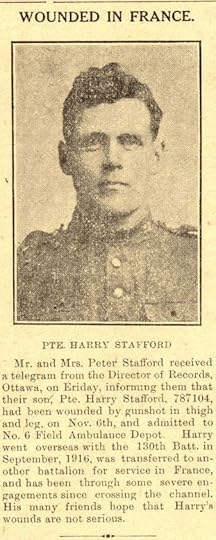
Harry’s condition never improved, and once again he was admitted to St. Luke’s Hospital in Ottawa on February 4th, 1920. He developed a cold two days after being admitted, and his operation was postponed until Feb 9th. Pneumonia developed 12 hours following operation, and Harry died two days later. There was speculation at the time that he may have contracted the flu while in the hospital, and that it turned to pneumonia in his already weakened state.
The influenza pandemic of 1917-1920 was a global disaster, and was actually responsible for killing more people than WWI. It has been said that it was the most devastating flu epidemic in recorded world history.
Because of the close quarters and huge troop movements during the war it is possible that these two factors hastened the pandemic and likely increased transmission of the virus. Many soldiers’ immune systems were weakened by lack of proper nutrition, the stresses of combat and chemical warfare, increasing their susceptibility to any illness.
Feb 20 1920 –“Died: In St. Luke’s Hospital, Ottawa on Thursday February 12th, Harry Alphonsus Stafford, son of Mr. and Mrs. Peter Stafford of Lanark, aged 20 years and 9 months.”Because he died at St. Luke’s Hospital in Ottawa, Harry’s death was registered in the County of Carleton, Division of Ottawa. His official cause of death was listed as pneumonia.
After a quick search on Ancestry.com, I found Harry’s death certificate:
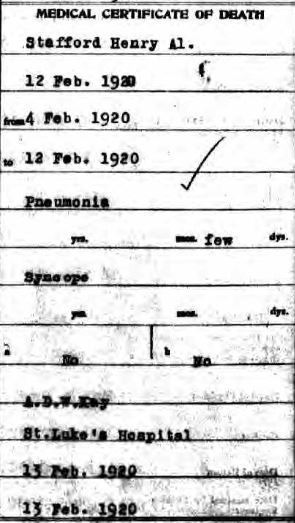
Harry is buried at the Sacred Heart Cemetery, Lanark, Ontario
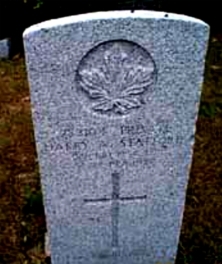
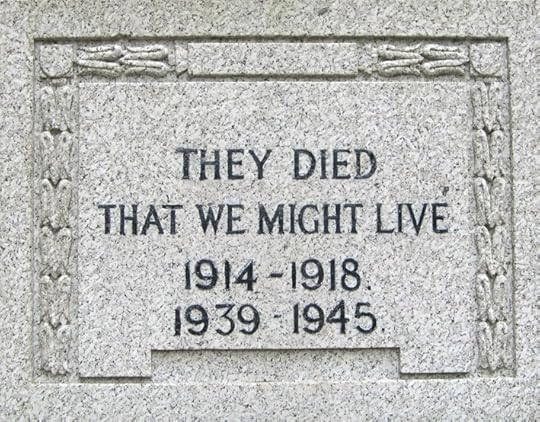
……………………
War Memorial, Ottawa, Canada

There are several resources listed below to help with your search.
……………………………………….
(the above is an excerpt from a book on the life and military service of Pte. Harry Stafford. The hard-cover book is available for research purposes at the Lanark Museum, 80 George Street, Lanark Ontario lanarkanddistrictmuseum@gmail.com, and at Archives Lanark, 1920 Concession 7 Road, Drummond Centre, Perth, Ontario adm.archiveslanark@bell.net)

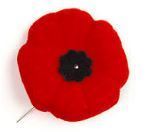 Lest We Forget
Lest We Forget………………………..
Link to: Canadian Soldiers of WWI
Link to Commonwealth War Graves
Link to Names in Book of Remembrance
…………………………
Arlene Stafford-Wilson
Member, Association of Professional GenealogistsHonorary Life Member, Lanark County Genealogical SocietyAuthor of : “Lanark County Christmas”, “Lanark County Comfort”, “Lanark County Collection”, “Lanark County Calling”, “Lanark County Classics”, “Lanark County Connections”, “Lanark County Calendar”, “Lanark County Chronicle”, “Lanark County Kid”, & “Recipes & Recollections”available at local stores or email: lanarkcountybooks@gmail.comNovember 9, 2022
WWII Soldiers from Perth and Area
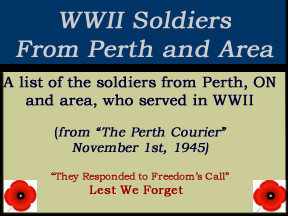





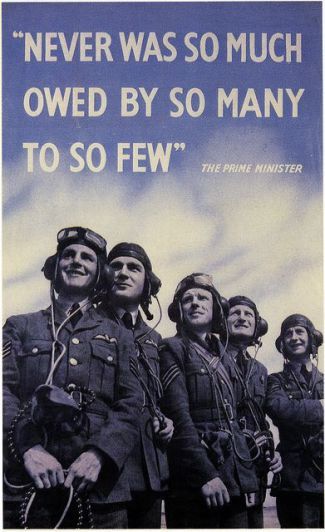
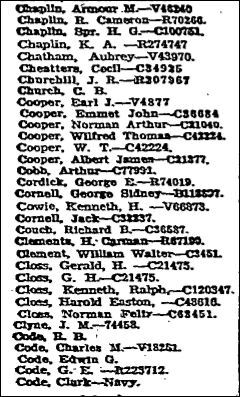

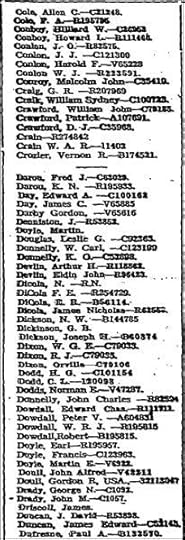
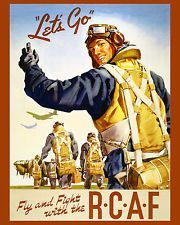

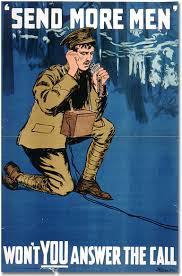
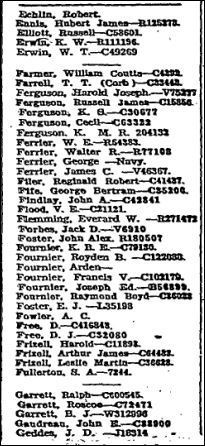
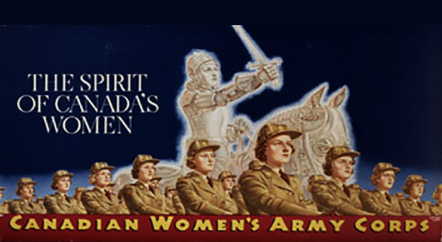

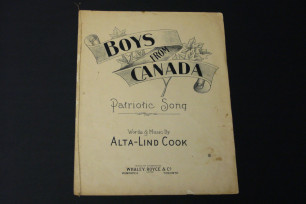
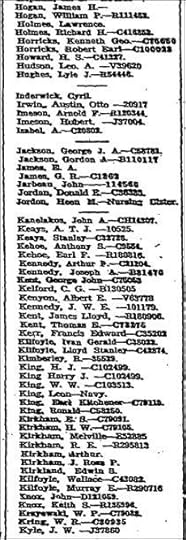
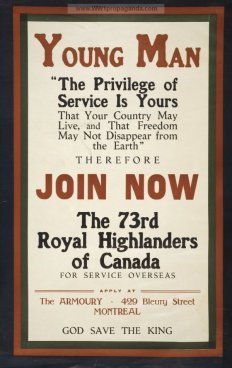
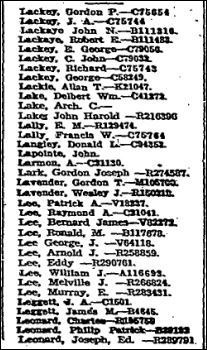
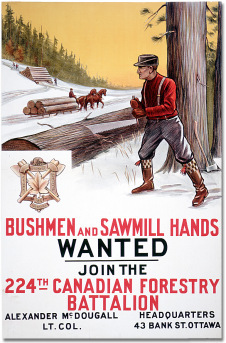
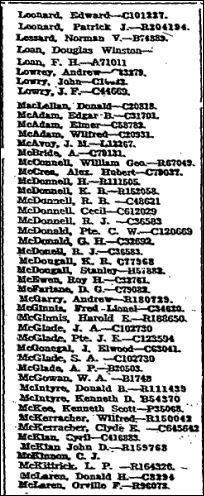
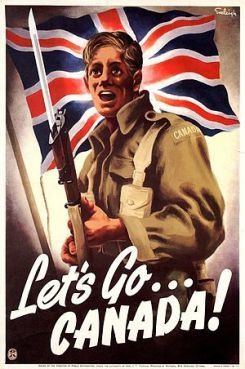
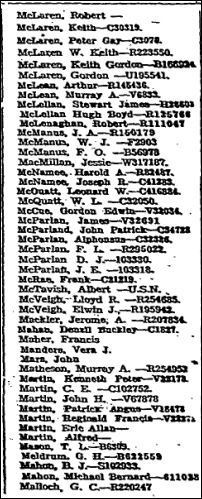


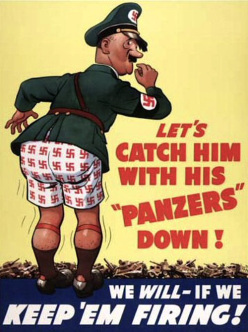
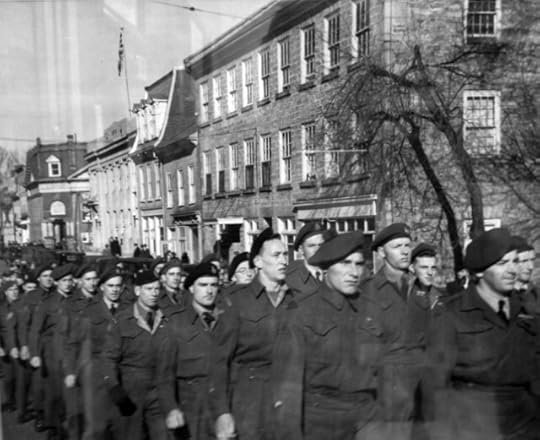
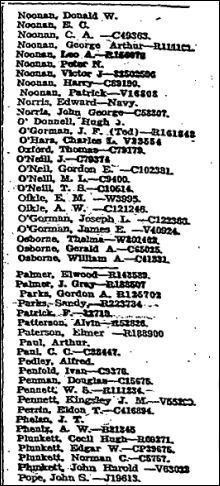

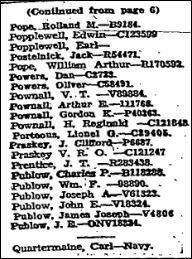

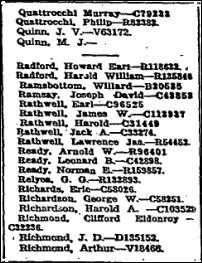

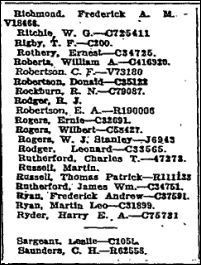
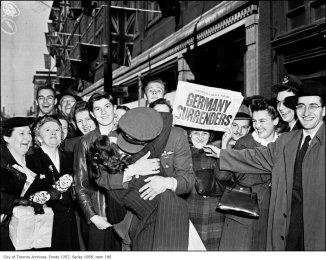
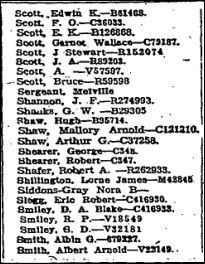
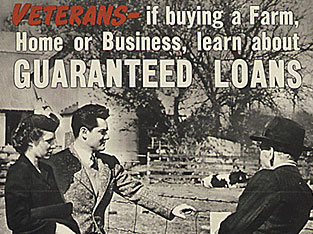
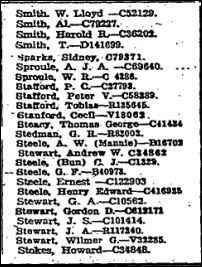
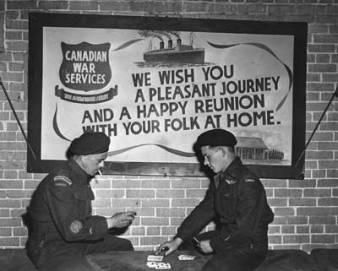
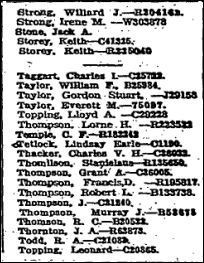
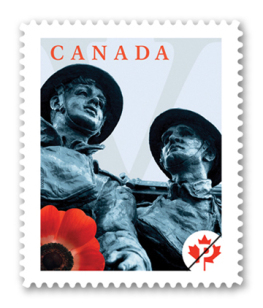
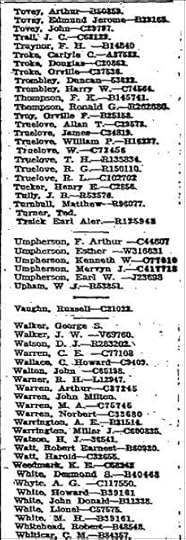

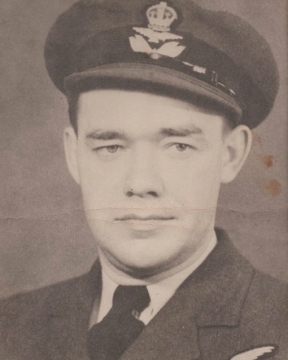
‘Perth Courier’ August 17, 1944
F.O. Robert White Now Presumed to Have Died“Mr. and Mrs. W. J. White, 15 Basin Street, have been advised by the Dept. of Defense, Ottawa, that their son, F.O. Robert White, who was reported missing after air operations over enemy territory on March 31, has now been presumed dead. A crew of seven manned the bomber which did not return and they are all presumed to have died. Shortly before he was reported missing on March 31, Bob was decorated with the D.C.M. at Buckingham Palace by the King.”
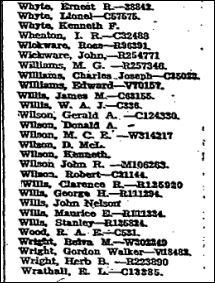
 Lanark and Renfrew Scottish Regiment “D” Company
Perth, Ontario, 1942
Lanark and Renfrew Scottish Regiment “D” Company
Perth, Ontario, 1942
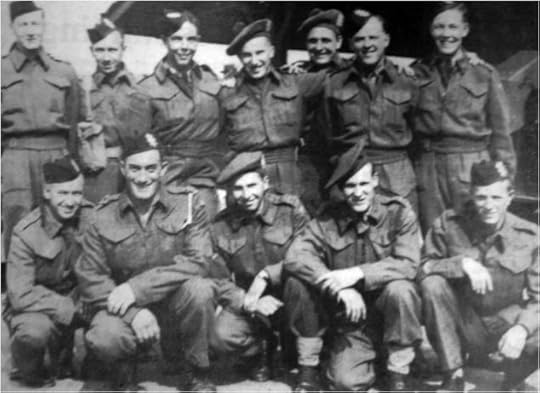
……………………………..
Missing from the Perth Courier’s list, but not forgotten:Burns, George
(submitted by Brenda Burns)Ferguson, Robert
Frizell, Ernest Darou, died 1943, buried overseas.
Goodson, Renfred ‘Bob’ Arthur
(submitted by Corinne Rivington)……………………………………………………………………
Hall, George Cecil
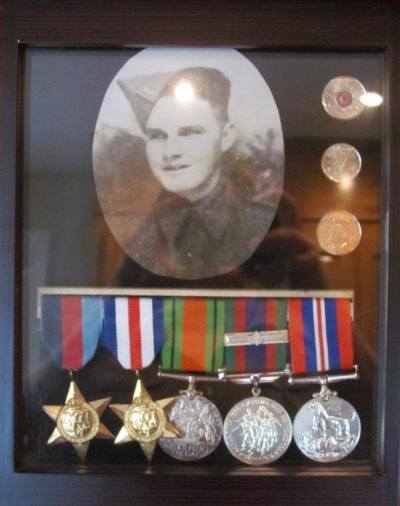
…………………………
Laroque, Kenneth Joseph
Lee, Joseph Patrick
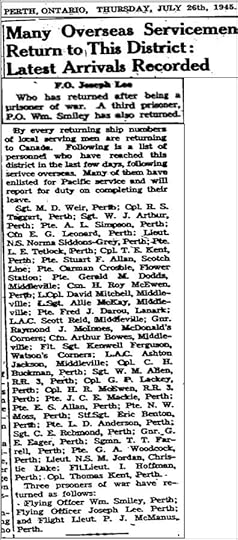
“Ormond’s war record shows that he landed in Sicily, and served throughout Italy, France, Germany, Belgium and Holland. Before he passed I asked him where he was when it was announced the war was over. His face lit up and he said, “I know exactly where I was. Nijmegen Holland.”
“Ormond Paul came home on the ‘Queen Elizabeth’, and was given a package with the Christmas dinner menu, a calendar for 1946, and a photo of the ship packed with soldiers.”
(notes from Roy Paul)
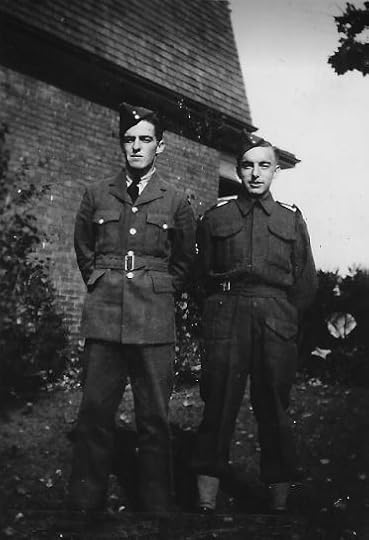
Paul, Ormond M.F. C-28750
Paul, Wilmer,
(from Poland, Ontario, photos submitted by Roy Paul)………………………………………………………
Rattray, Howard John
Rattray, Willard Arnold
Rattray, Clarence William
Rattray, John Elmer
…………………………………………………….
Weir, William Devlin
……………………………………………………..
Wood, Alva
Wood, Eldon ‘Pete’
Wood, Elva
(from Snow Road) – submitted by Trish Fournier……………………………………………………….

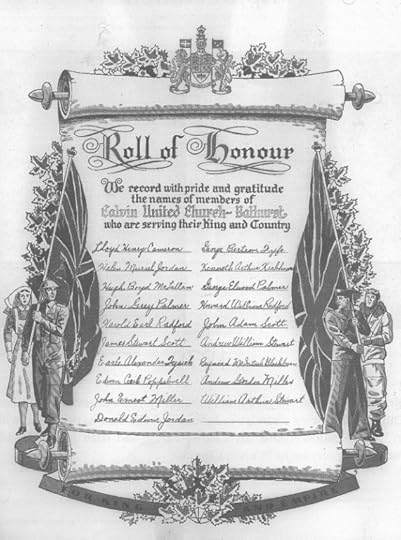




……………….
Local War Heroes: Kyle, McGlade, and DicolaFRIDAY, MAY 14, 2010
Article by ‘St. John’s School’, Perth, Ontario:
St. John’s School Playgroundto Be Dedicated to Local Fallen Heroes and Veterans“The St. John Playground Committee has chosen two local fallen Canadian Forces heroes and one local Veteran to be part of the dedication of their new playground.
The fundraising efforts for the new playground at the school taking place under the auspices of the Let Them Be Kids foundation dictates that any new playgrounds built are dedicated to a Canadian Forces fallen soldier or veteran from the area. After much reading and research by a Grade 6 class at the school, St. John’s has chosen Flying Officer William Kyle, Corporal James Michael McGlade, and veteran Corporal Francis DiCola to immortalize in the dedication of their new play structures.
Flying Officer William Kyle, born and raised in Perth, flew Dakota aircraft as a member of the RCAF 453 Transport Squadron based out of Tulihal, India. His squadron was responsible for moving freight and soldiers to and from various bases throughout the South Pacific. On June 21, 1945, a mission Kyle was on failed to return. The story of the missing aircraft came to prominence more than 50 years later, when the wreckage of the missing plane was discovered in the jungles of northwestern Myanmar (Burma), and Veterans Affairs Canada sought to uncover the wreckage and bring it home. Flying Officer Kyle’s watch, found at the scene, allowed Veterans Affairs to identify the crew and the plane.
Corporal James Michael McGlade, born in Perth and a graduate of St. John Separate School and PDCI High School, served the Canadian Forces as a member of the Royal Hamilton Light Infantry. Corporal McGlade signed up for the military in 1940 and was deployed overseas in 1942. Stationed in Antwerp, Belgium, Corporal McGlade’s regiment was responsible for the liberation, capture and preservation of the vital harbour and dock facilities at Antwerp. He was killed there in 1944 and is buried in Schoonselhof Cemetery in Belgium.
Corporal Francis E. DiCola, also a graduate of St. John Separate School and PDCI, enlisted in the Royal Canadian Air Force as a 17 year old in 1943. As a member of the RCAF Squadron 422 he was stationed at Pembroke Dock in Wales and worked as a radio operator. His job was to dispatch aircraft to various bases throughout Great Britain and the continent. While he was offered the opportunity to act as a guard during the Nuremberg Trials after the war, Corporal DiCola was anxious to return to Canada. He took advantage of the RCAF education packages offered to returning soldiers and took an economics degree at University of Toronto before returning to Perth to run the family business, DiCola Petroleum. Here he raised 7 children with his wife, Rose, and as a businessman and father, has contributed to countless endeavors in our community.
St. John’s is proud to dedicate their new play structures and schoolyard to these local Forces heroes. While the children are playing on the structures building their bodies and friendships, may they also be aware of these brave men who gave of themselves so that we could be free.”
…………………………………….
Be Sure to Visit the Perth Legion Hall of Remembrance:The Hall of Remembrance displays include artifacts donated by local veterans and their families such as war medals, letters, photographs, souvenirs, and display cabinets featuring army and navy memorabilia. The collection focuses on Perth and area’s contributions in World War I, World War II, Korea, Cold War, peacekeeping missions, and Afghanistan.
http://www.hallofremembrance.ca/exhibits/index.html
Hall of Remembrance – Royal Canadian Legion Branch 244, Perth-Upon-Tay – 26 Beckwith Street East Perth, ON K7H 1B5 Tel: 613-267-4400 (Office)………………………………………….
Library and Archives Canada Links for WWII Research:
………………………………………..
Search the Canadian Fallen Heroes Database:
Canadian Fallen Heroes Database
……………………………………………………………………………………………………………………………………………….
This tribute isin memory of all of the soldiers from the Perth areawho fought bravely for our country,so that we might live in peace and freedom.Lest We Forget………………………………………………………………………………………………………………………………………………………

…………………………………………
Arlene Stafford-Wilson
Member, Association of Professional GenealogistsHonorary Life Member, Lanark County Genealogical SocietyAuthor of : “Lanark County Christmas”, “Lanark County Comfort”, “Lanark County Collection”, “Lanark County Calling”, “Lanark County Classics”, “Lanark County Connections”, “Lanark County Calendar”, “Lanark County Chronicle”, “Lanark County Kid”, & “Recipes & Recollections”Books available at local stores or email: lanarkcountybooks@gmail.com
November 7, 2022
The Humm Reviews “Lanark County Christmas”

Glenda Jones reviews:
“Lanark County Christmas”
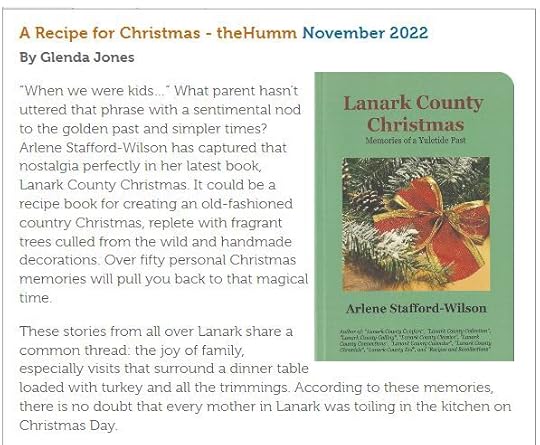
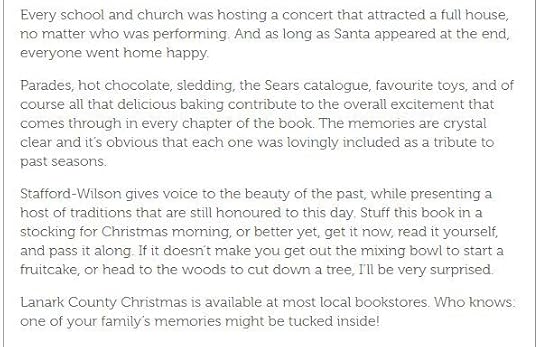
Link to the article in “The Humm”
https://www.thehumm.com/online/article.cfm?articleid=3333
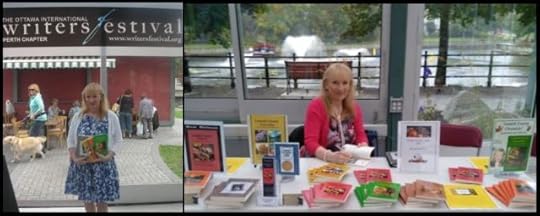
Arlene Stafford-Wilson
Member, Association of Professional Genealogists
Honorary Life Member, Lanark County Genealogical Society
Author of : “Lanark County Christmas”, “Lanark County Comfort”, “Lanark County Collection”, “Lanark County Calling”, “Lanark County Classics”, “Lanark County Connections”, “Lanark County Calendar”, “Lanark County Chronicle”, “Lanark County Kid”, & “Recipes & Recollections”
available at local stores or email: lanarkcountybooks@gmail.com

